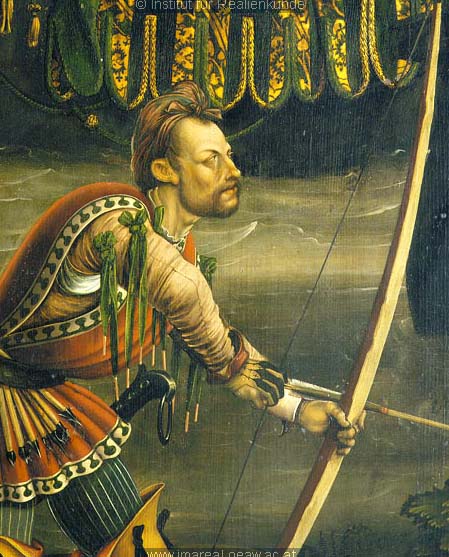
Something interesting from a recent excursion in 16th c. German artwork. Note the detail in bow, glove, arrows (tucked into belt in a fan formation), etc. A rare view, I think.
 Attachment: 108.61 KB
Attachment: 108.61 KB


Thanks for the image, Sean! Do you have a link to the full painting?
Other things of note are the armour points at the shoulder, as well as the ring on the pommel of the messer.
Other things of note are the armour points at the shoulder, as well as the ring on the pommel of the messer.
Very impressive painting. Awesome. :D
Here are the other available images:
Schifffahrt der Hl. Ursula
Dieses Bild: 015752
Kunstwerk: Malerei-Holz ; Tafelbild ; Burgkmair Hans der Ältere (1473-1531) ; Augsburg ; Ursula:01:017-022
Dokumentation: 1504 ; 1504 ; Augsburg ; Deutschland ; Schwaben ; Staatsgalerie im Schaezler-Palais ; 5339
Anmerkungen: Augsburg, Dominikanerinnenkloster St. Katharina, Kapitelsaal ; Basilica Santa Croce ; Kat. "Altdeutsche Gemälde der Staatsgalerie Augsburg, Städtische Kunstsammlungen, Bd. 1 (Hrsg. Bayerische Staatsgemäldesammlungen) München 1988, S. 146-151.
 Attachment: 94.23 KB
Attachment: 94.23 KB
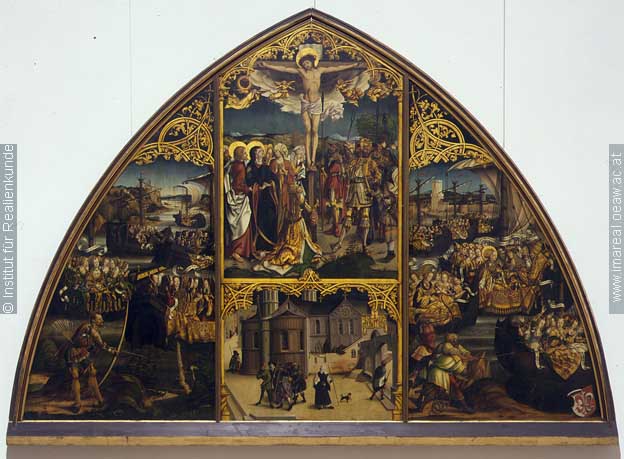
 Attachment: 89.42 KB
Attachment: 89.42 KB
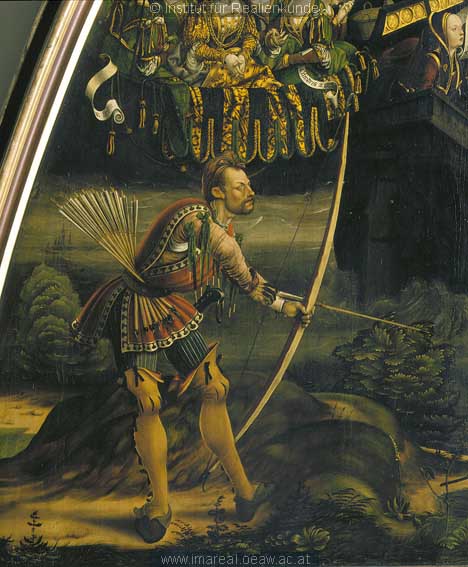
Schifffahrt der Hl. Ursula
Dieses Bild: 015752
Kunstwerk: Malerei-Holz ; Tafelbild ; Burgkmair Hans der Ältere (1473-1531) ; Augsburg ; Ursula:01:017-022
Dokumentation: 1504 ; 1504 ; Augsburg ; Deutschland ; Schwaben ; Staatsgalerie im Schaezler-Palais ; 5339
Anmerkungen: Augsburg, Dominikanerinnenkloster St. Katharina, Kapitelsaal ; Basilica Santa Croce ; Kat. "Altdeutsche Gemälde der Staatsgalerie Augsburg, Städtische Kunstsammlungen, Bd. 1 (Hrsg. Bayerische Staatsgemäldesammlungen) München 1988, S. 146-151.


What I also find interesting is the size of the bow.
The bow is clearly yew, so I know the sorts of powers for the diameters, in a very general sense and that is a whopper. The whole painting is so 'real' I feel that this detail is not wrong. I always understood that English bowmen shot heavy bows due to the legal practice requirements allowing frequent practice and so developing ability and strength and that fundamentally other nations couldn't really compete due to this. That bow looks to me to be at least a 140lb which would compare against any respectable English archer.
The bow is clearly yew, so I know the sorts of powers for the diameters, in a very general sense and that is a whopper. The whole painting is so 'real' I feel that this detail is not wrong. I always understood that English bowmen shot heavy bows due to the legal practice requirements allowing frequent practice and so developing ability and strength and that fundamentally other nations couldn't really compete due to this. That bow looks to me to be at least a 140lb which would compare against any respectable English archer.
I'm glad to hear you confirm this! I was surprised by both the size and what looks to my untutored eyes to be a very rough finish. I'm glad I don't have to regularly bend a hardwood 2x2 for a living!
| Leo Todeschini wrote: |
| What I also find interesting is the size of the bow.
The bow is clearly yew, so I know the sorts of powers for the diameters, in a very general sense and that is a whopper. The whole painting is so 'real' I feel that this detail is not wrong. I always understood that English bowmen shot heavy bows due to the legal practice requirements allowing frequent practice and so developing ability and strength and that fundamentally other nations couldn't really compete due to this. That bow looks to me to be at least a 140lb which would compare against any respectable English archer. |
Hi Tod,
A bow of those proportions (if correct) would have to be made of a very poor quality yew - that is, yew grown in warm wet climates. I have a bow made of English (possible Irish) yew and that has a similar 'massive' look; yet it only draws about 125lb. Your guess of about 140lb would be reasonable for a bow of that girth.
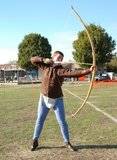
A bow made of high-quality, high-altitude yew, to those proportions would be unmanageable by a human - in the order of 300+ pounds!
Last year Italian bowyer Celestino Poletti made a high-altitude yew bow to Mary Rose dimensions (considerably smaller than our German fellow's bow) . The bow came in at 202lb @ 32" - as far as I'm aware the heaviest self-longbow in the world.
Well, http://www.longbow-archers.com/heavybowarchers.htm in 4th paragraph it's stated that the longer bow with given draw weight is, the easier it's to draw, although there are of course many limits too.
What do you think about that statement?
P.S. How can I make my link appear as "here" "check this" or something, instead of full adress? I can't figure it out on this site.
What do you think about that statement?
P.S. How can I make my link appear as "here" "check this" or something, instead of full adress? I can't figure it out on this site.
Interesting hilt on the messer as well. Is the large ring common?
| Bartek Strojek wrote: |
| Well, http://www.longbow-archers.com/heavybowarchers.htm in 4th paragraph it's stated that the longer bow with given draw weight is, the easier it's to draw, although there are of course many limits too.
What do you think about that statement? |
Bartek,
That information is fundamentally correct: a bow with longer limbs can feel easier to draw. However, a long limbed bow may not have as much cast (throw an arrow as far) since the long limbs are heavier and take more energy to accelerate (so less for the arrow).
Other factors include: shape of the limbs (tiller) and wood.
Interesting painting. "German" longbowmen aren't something that comes to mind at all, really. He also wears gloves, which is a symbol of the upper class, is it not?
M.
M.
| M. Eversberg II wrote: |
| Interesting painting. "German" longbowmen aren't something that comes to mind at all, really. He also wears gloves, which is a symbol of the upper class, is it not?
M. |
Looks like it's just a three-finger archer's glove on the right hand. Left hand isn't clear enough to tell.
| Allen Andrews wrote: |
| Interesting hilt on the messer as well. Is the large ring common? |
The ring does seem to have been common but I have no idea what purpose it served. Dürer shows at least one and, IIRC, they're commonly seen in depictions of the martyrdom of St. Barbara. The weapons typically have an eastern European look to them and I wonder if there might be some Turkish influence. In fact, one often sees these associated with figures in what I'd call Near Eastern dress--turbans and such. Maybe it was an aesthetic fad of the period. I'll see if I can dig up another example.
More Info:
St. Ursula, whose life is depicted in the painting in question, is said to have died after being attacked by Huns during a pilgrimage. That might explain the the more exotic elements of the archers's costume. See also Memling's depiction of the martyrdom of St. Ursula (first image below). Notice the archer.
St. Barbara, mentioned above as commonly associated with depictions of eastern-looking swords, was said to have lived and died in Anatolia, modern Turkey. So, there certainly is Turkish influence on those paintings. The remaining question is whether these were mere artistic conventions or depictions of actual arms, either in use by the Europeans or closely observed by them in combat or as war trophies, etc.
Everything else--the other arms and armour--tends to be well observed, but the danger lies in the fact that so many of these paintings are of Biblical scenes. The artists may be using a familiar foundation of European imagery with a few foreign "stock" images thrown in to provide an exotic Eastern flavor--a turban, saber, non-European dress, etc. That helps explain why the father/executioner in St. Barbara paintings is usually depicted as shown below.
 Attachment: 103.25 KB
Attachment: 103.25 KB
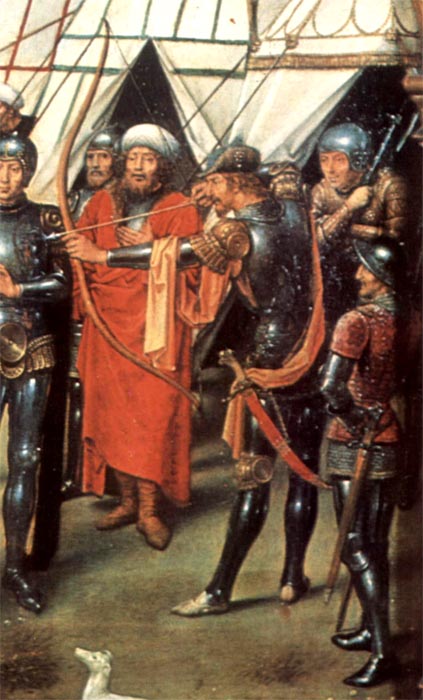
 Attachment: 134.74 KB
Attachment: 134.74 KB
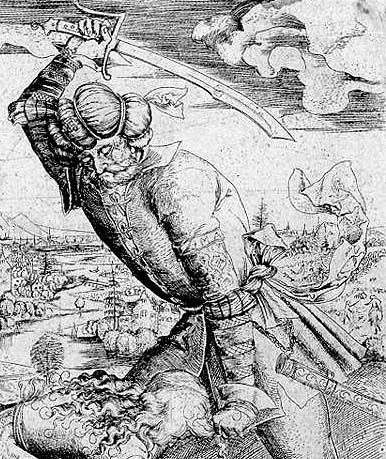
 Attachment: 87.83 KB
Attachment: 87.83 KB
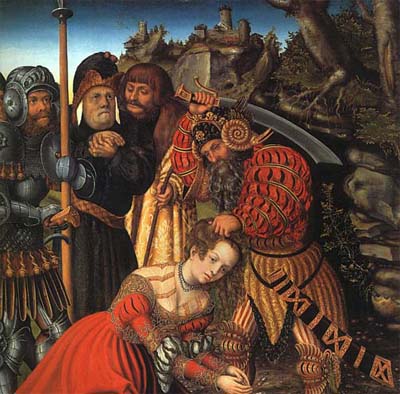
St. Ursula, whose life is depicted in the painting in question, is said to have died after being attacked by Huns during a pilgrimage. That might explain the the more exotic elements of the archers's costume. See also Memling's depiction of the martyrdom of St. Ursula (first image below). Notice the archer.
St. Barbara, mentioned above as commonly associated with depictions of eastern-looking swords, was said to have lived and died in Anatolia, modern Turkey. So, there certainly is Turkish influence on those paintings. The remaining question is whether these were mere artistic conventions or depictions of actual arms, either in use by the Europeans or closely observed by them in combat or as war trophies, etc.
Everything else--the other arms and armour--tends to be well observed, but the danger lies in the fact that so many of these paintings are of Biblical scenes. The artists may be using a familiar foundation of European imagery with a few foreign "stock" images thrown in to provide an exotic Eastern flavor--a turban, saber, non-European dress, etc. That helps explain why the father/executioner in St. Barbara paintings is usually depicted as shown below.



The back of the bow (facing the shooter) seems to be square. If it is square, that is a significant difference from the English long bow of the same period as the English made "D" shaped bows. Flat on the front (side facing the opponent) and rounded on the back (side facing the shooter).
In my opinion there is a little artistic creativity going on too with how the arrows are being carried. To illustrate my point, these are "War Arrows" (heads with barbs). As such an archer would have never carried them in his belt like that. The first reason is because it would be too easy to fall on uneven terrain and skewer ones self on the arrows. The second is the arrow will snag the belt each time the archer attempts to withdraw one. Not exactly smart when your life may depend on how many arrows you can loose before a well armed knight rides up and takes your head off. The glove however makes a lot of sense because without some protection to your fingers, you would have a very painful experience pulling a bow of high draw weight.
In my opinion there is a little artistic creativity going on too with how the arrows are being carried. To illustrate my point, these are "War Arrows" (heads with barbs). As such an archer would have never carried them in his belt like that. The first reason is because it would be too easy to fall on uneven terrain and skewer ones self on the arrows. The second is the arrow will snag the belt each time the archer attempts to withdraw one. Not exactly smart when your life may depend on how many arrows you can loose before a well armed knight rides up and takes your head off. The glove however makes a lot of sense because without some protection to your fingers, you would have a very painful experience pulling a bow of high draw weight.
| Allen Foster wrote: |
|
In my opinion there is a little artistic creativity going on too with how the arrows are being carried. To illustrate my point, these are "War Arrows" (heads with barbs). As such an archer would have never carried them in his belt like that. The first reason is because it would be too easy to fall on uneven terrain and skewer ones self on the arrows. The second is the arrow will snag the belt each time the archer attempts to withdraw one. Not exactly smart when your life may depend on how many arrows you can loose before a well armed knight rides up and takes your head off. The glove however makes a lot of sense because without some protection to your fingers, you would have a very painful experience pulling a bow of high draw weight. |
At least one of the archers in the Maciejowski bible carries his arrows that way. Also a common way to carry in the in the east so I would't put that to artistic creativity. Instead of pulling the arrows up you just pull them down and no snagging will occur.
http://www.caama.ca/images/imagemac.html
Edit: replaced the link to the picture to a site with more archers from the Maciejowski bible
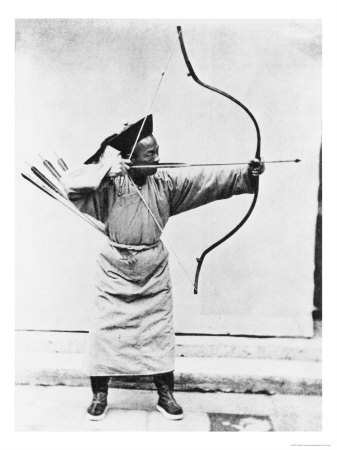
Chinese Archer, circa 1870
Interesting. Being a modern day archer I never would have thought anyone would carry an arrow like that for the very same reasons I stated.
| Stefan Toivonen wrote: | ||
At least one of the archers in the Maciejowski bible carries his arrows that way. Also a common way to carry in the in the east so I would't put that to artistic creativity. Instead of pulling the arrows up you just pull them down and no snagging will occur. http://www.caama.ca/images/imagemac.html Edit: replaced the link to the picture to a site with more archers from the Maciejowski bible |
Don't forget to watch what he is wearing on is head. Never seen that before. Was it common for men to wear something like that?
shooting gloves were around, but not that common in my understanding, although I think one was pulled up from the Mary Rose.
Tod
Tod
| A.A. Boskaljon wrote: |
| Don't forget to watch what he is wearing on is head. Never seen that before. Was it common for men to wear something like that? |
It just look like something what ensures that hair won't fall on his eyes.
His hair doens't appear to be long, though.
Page 1 of 2
You cannot post new topics in this forumYou cannot reply to topics in this forum
You cannot edit your posts in this forum
You cannot delete your posts in this forum
You cannot vote in polls in this forum
You cannot attach files in this forum
You can download files in this forum
All contents © Copyright 2003-2006 myArmoury.com — All rights reserved
Discussion forums powered by phpBB © The phpBB Group
Switch to the Full-featured Version of the forum
Discussion forums powered by phpBB © The phpBB Group
Switch to the Full-featured Version of the forum